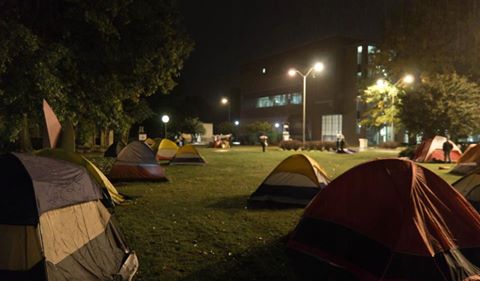Jessica Fisher, Contributor
On the night of Nov. 7th tents set up in a rag tag fashion reminiscent of Occupy Camps of years past, were set up outside of the social science building.
While observing the display in the Social Science Atrium, one student, who was taking part in the Sleep Out commented to me that they’d have to go home to get their sleeping bag, something they would not be able to do if they were actually homeless.
To hear students sit around and talk about Homelessness Awareness Week (HAW for short), the main topic of discussion was the effectiveness of the Sleep Out. Did it raise awareness? Was it in authentic since the people sleeping out in solidarity could technically go home if they wanted to or needed to?
Can those who are not homeless understand the severity of homelessness? What does it mean to be homeless? A public attorney presiding as ‘judge’ at Friday night’s Moot Court emphatically stated that, “The poor and the homeless do not get a fair shake in the court or by the police.”
Participants in HAW’s Sleep Out not only could go home, but were also able to bring things from home; tents, sleeping bags, blankets, pillows, etc.
The Free Application for Federal Student Aid (FAFSA) reports that 58,000 students across the country are homeless.
The Campus Awareness, Resource & Empowerment (C.A.R.E.) Center is the department on campus that is responsible for organizing HAW each year. They partner with organizations such as Family Promise of Cobb County, Must Ministries and The Center for Family Resources. All three organization are located in Cobb County and do work to help people who are homeless.
For all the organizations in Cobb County that stand to help homeless people in the area, there is one group these organizations may not be helping. If you are Lesbian, Gay, Bisexual or Transgender (LGBT), there is only one place in the state, in Atlanta to be exact, where you will be advised to go.
While the Walk Home event took place on the campus green, the Moot Court took place in the Social Science building and the Memorial Vigil & Service took place at the Legacy Gazebo, but there may be one HAW event, that even if seem, may not have been understood.
The GLBTIQ (Gay, Lesbian, Bisexual, Transgender, Intersex and Questioning) Student Retention Services office partnered this year with the C.A.R.E. Center to present for the first time, the severe case of LGBT homelessness. GLBTIQ Student Retention Services Program Coordinator Jessica Duvall had this to say about the inagurual effort, “This year was the first year we were able to include an LGBTQ perspective into the events and now having done so the next step is to expand the conversations. But in order to do that, we need to first raise awareness to the fact that LGBTQ youth are disproportionally impacted by homelessness.”
The display included 1,000 rainbow flags placed out on the Student Center Terrace. Each flag represented 14 homeless LGBT youth in the United States at any given time.
Duvall addressed how even our view of homelessness has been molded into a stereotype that forces many people out of the frame:
“Too often, I feel, we have this image ingrained on us of an old man living in a box on the streets as the sole image of homelessness. While, unfortunately, this image is accurate of many people’s experience, it also ignores a myriad of demographics that are disproportionately impacted by homelessness and the ways they cope.”
The reality of homelessness is not static, nor one dimensional, “This static image ignores those who may be couch-surfing or living in their cars. It also ignores the number of homeless unattended youth as well as families that experience periods of homelessness.”
Duvall noted that despite what happens off campus, if you are a student at KSU, you have resources and options, “In terms of accessing services, the KSU Care Center is an excellent resource for students in need. The C.A.R.E. Center can provide students with direct services and/or connect them with outside organizations as needed.”
Duvall names Lost-n-Found Youth as the organization eluded to earlier where homeless LGBT youth (those 26 and younger) can go.
In addition to awareness, the Sleep Out, and Homelessness Awareness Week as a whole, does something else to make a difference. The C.A.R.E. Center is also raising funds for a HAW scholarship. According to the HAW website, the money raised for the scholarship goes towards helping students who are homeless, … “achieve their educational goals and to provide resources such as scholarships, housing, meal plans, etc.”
A fundraising dinner for the scholarship was held on November 5th.
– – –
Sources: http://dailyorange.com/2014/09/rodgers-university-should-better-address-the-needs-of-homeless-students/


